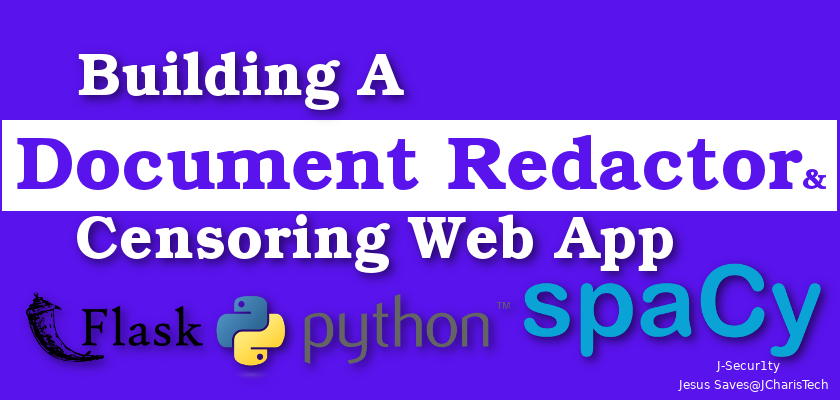Document Redaction & Censoring Web App with SpaCy
In this tutorial we will be building a document redaction and sanitization web application with flask and spacy. We will be using spaCy’s named entity recognition to help us in our document redaction and censorship.
SpaCy has a very powerful named entity recognition feature that allows us to do some interesting things with it.
This web app has two parts with the following structure
- static
- templates
- app.py
Front-End
We will be using material design bootstrap for designing our front-end.
check full code here with front-end here
Back-End
We will be using python’s flask micro-framework as our back-end.
Below is the code for the backend
from flask import Flask,url_for,render_template,request,send_file,redirect
from flask_uploads import UploadSet,configure_uploads,ALL,DATA
from werkzeug import secure_filename
# Other Packages
import os
import spacy
nlp = spacy.load('en')
import time
timestr = time.strftime("%Y%m%d-%H%M%S")
# Initialize App
app = Flask(__name__)
# Configuration For Uploads
files = UploadSet('files',ALL)
app.config['UPLOADED_FILES_DEST'] = 'static/uploadedfiles'
configure_uploads(app,files)
# Functions to Sanitize and Redact
def sanitize_names(text):
docx = nlp(text)
redacted_sentences = []
for ent in docx.ents:
ent.merge()
for token in docx:
if token.ent_type_ == 'PERSON':
redacted_sentences.append("[REDACTED NAME]")
else:
redacted_sentences.append(token.string)
return "".join(redacted_sentences)
def sanitize_places(text):
docx = nlp(text)
redacted_sentences = []
for ent in docx.ents:
ent.merge()
for token in docx:
if token.ent_type_ == 'GPE':
redacted_sentences.append("[REDACTED PLACE]")
else:
redacted_sentences.append(token.string)
return "".join(redacted_sentences)
def sanitize_date(text):
docx = nlp(text)
redacted_sentences = []
for ent in docx.ents:
ent.merge()
for token in docx:
if token.ent_type_ == 'DATE':
redacted_sentences.append("[REDACTED DATE]")
else:
redacted_sentences.append(token.string)
return "".join(redacted_sentences)
def sanitize_org(text):
docx = nlp(text)
redacted_sentences = []
for ent in docx.ents:
ent.merge()
for token in docx:
if token.ent_type_ == 'ORG':
redacted_sentences.append("[REDACTED]")
else:
redacted_sentences.append(token.string)
return "".join(redacted_sentences)
def writetofile(text):
file_name = 'yourdocument' + timestr + '.txt'
with open(os.path.join('static/downloadfiles',file_name),'w') as f:
f.write(text)
@app.route('/')
def index():
return render_template('index.html')
@app.route('/sanitize',methods=['GET','POST'])
def sanitize():
if request.method == 'POST':
choice = request.form['taskoption']
rawtext = request.form['rawtext']
if choice == 'redact_names':
result = sanitize_names(rawtext)
elif choice == 'places':
result = sanitize_places(rawtext)
elif choice == 'date':
result = sanitize_date(rawtext)
elif choice == 'org':
result = sanitize_org(rawtext)
else:
result = sanitize_names(rawtext)
return render_template('index.html',rawtext=rawtext,result=result)
@app.route('/uploads',methods=['GET','POST'])
def uploads():
if request.method == 'POST' and 'txt_data' in request.files:
file = request.files['txt_data']
choice = request.form['saveoption']
filename = secure_filename(file.filename)
file.save(os.path.join('static/uploadedfiles',filename))
# Document Redaction Here
with open(os.path.join('static/uploadedfiles',filename),'r+') as f:
myfile = f.read()
result = sanitize_names(myfile)
if choice == 'savetotxt':
new_res = writetofile(result)
return redirect(url_for('downloads'))
elif choice == 'no_save':
pass
else:
pass
return render_template('result.html',filename=filename,result=result,myfile=myfile)
@app.route('/downloads')
def downloads():
files = os.listdir(os.path.join('static/downloadfiles'))
return render_template('downloadsdirectory.html',files=files)
if __name__ == '__main__':
app.run(debug=True)
Below is a video tutorial of the entire process.
Thanks for your time
By Jesse JCharis
Jesus Saves@JCharisTech
